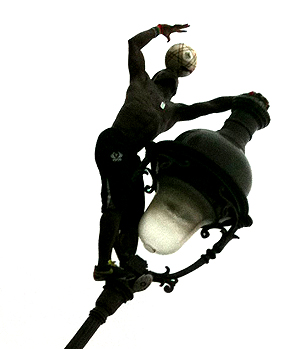Below you’ll find an outline of my research proposal. My background is in music and visual performance, new media art and the area of my inquiry is Sound Design, thus, as you’ll see, the investigation is oriented towards a more practical approach compared to the other ones published here.
Apologies, but authors I refer to in the text are not properly cited (I couldn’t publish the bibliography), if you’re interested in learning more, please, feel free to contact me.
This research seeks to investigate to which extent a human body can be considered – and played as – a musical instrument and how such envision could enhance the methodology of music performance.
To further elaborate the question I shall introduce here an analogy. The varied system of intimate vibrating energy, guttural sounds, primal screams known as voice can be considered the first musical instrument ever available to human kind. Not only voice gathers distinctive elements of an acoustical musical instrument, such as diversification of timbre and capability of virtuosic control, but augments them in an unpredictable, subtle and highly subjective fashion. This makes of human voice a unique musical instrument, incomparable with any other.
Consider now how human body is similarly capable of infinite movement combinations and expressive subtlety, not to mention the virtuosic control which can be achieved with practice, as for dancers and sport professionals.
We can admit the body presents many resemblances with an acoustical instrument; consider the dynamic amplitude range which a piano, or flute can produce, likewise, the body is able to perform an impressive range of movements and to transform any amount of muscular energy in kinetic event, from the most elusive to the most emphatic and yet across a full range of interminable nuances. I argue, therefore, that uncharted musical capabilities are intrinsic to the human body.
It is important to note, though, that investigations in biosensing technologies for musical applications are nothing new. Following in the track of pioneers as Alvin Lucier and David Rosenboom advanced Body Music instruments and Brain-Computer Music Interfaces have been developed and discussed over the past thirty years and notable, recent findings in this area have been reported by Arslan, Filatriau and Kessous, Miranda, Nagashima, Tanaka. Presently at SARC1 a researchers group, lead by instruments creator and main contributor to the Bio Muse project (a commercialized product exploiting electromyography and brainwaves analysis systems for musical applications) Ben Knapp, is implementing notable biophysical-only music performances and installations such as the Bio Muse Trio and GroundMe!.
However, a careful analysis of those investigations and their findings led me to recognize two approaches to the use of biosensing technologies. On one side stands a technological celebration, the well-crafted and admittedly successful performance of a mere device, which cannot structurally fail nor output unexpected results; in this context we experience a paradoxical momentum: a device created to augment the body overcome the naturally unpredictable and non-linear behaviours of the body itself, thus denying its nature. A second approach I hint at consists of a musical performance where technology is simply intended as an adaptive mean of interaction with an erratic form (the body) and will, therefore, disappear beneath the multi-layered surface and spontaneous richness of human action vocabulary, thus, intensifying the act of human performance.
In order to demonstrate such conception I aim to investigate the use of kinetic and biophysical energy continuously produced by a body as mean of non-linear interaction with real time applications for musical performance.
It is arguable that the inquiry illustrated here could possibly outline novel control and musical paradigms which, on turn, could enrich and deepen the bipolar meme musician/instrument that constitutes a foundation of music performance.
1 Queen’s University, Sonic Art Research Center, Belfast, UK



